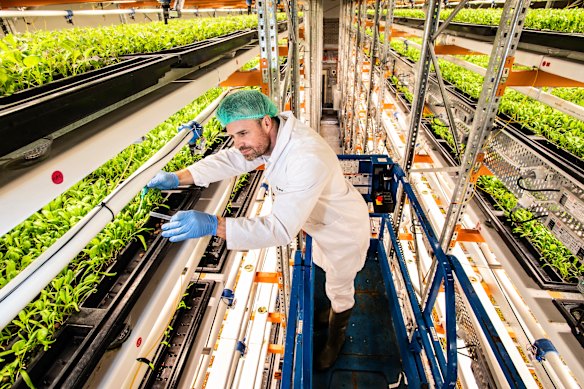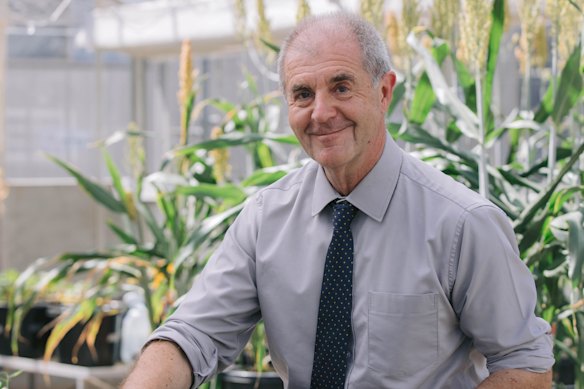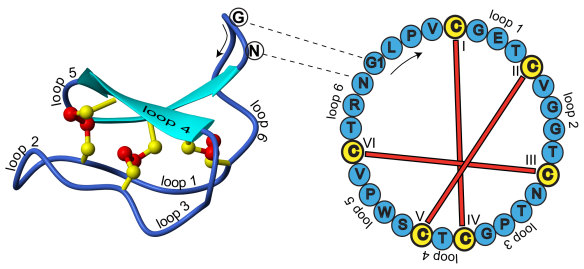By Angus Dalton
Painkiller peanuts, cholesterol-slashing salads and French fries that work like Ozempic could be closer to reality, with a decades-long research effort to make foods into medicine teaming up with a robot-powered plant factory in Sydney.
In the 1990s, Professor David Craik from the University of Queensland (UQ) discovered a type of circular peptide, which is a tiny protein, within the leaves of a plant used in African traditional medicine. He named the new molecules “cyclotides” and began studying their enormous medical potential.

Sebastien Eckersley-Maslin at Phyllome’s robot-powered “farm”, which will host plants that may one day grow edible medicine. Credit: Steven Siewert
Now, UQ, PharmaCare and Sydney automatic farming company Phyllome have linked up under a $1.2 million Australian Research Council grant to pursue the idea of growing helpful peptides directly into fruits, vegetables and seeds, creating medicine you can eat.
“We’ve discovered peptides that have activity against cancer, obesity and multiple sclerosis, and we’ve been interested in pursuing those as drugs for a number of years,” Craik said.
“We always had the idea, could we use plants as bio-factories? And even, one day, have these medicines in an edible plant?”
Peptides make for promising new drugs because they’re natural and highly specific at what they do, limiting the risk of side effects. But they’re also easily destroyed by digestion.

Professor David Craik works at the University of Queensland and is the director of the ARC Centre of Excellence in Peptide and Protein Science.
The structure of Craik’s circular peptides, however, means they’re resistant to heat, acid and digestion, and are therefore useful as possible drugs.
Craik’s team has previously taken a peptide discovered within the deadly venom of cone snails and re-engineered it to be circular; the resulting molecule proved a powerful painkiller in animal trials.
“It’s about 100 or so times more potent than gabapentin, which is the clinically used drug for neuropathic pain,” Craik, from UQ’s Institute for Molecular Bioscience, said. His team then genetically tweaked mustard plants to produce the venom-derived cyclotide.
“Those seeds are tiny, the size of a pinhead, so they’re never going to be enough to be therapeutic. But we’d be interested in putting it into something bigger … peanuts or chickpeas.”

The circular structure of cyclotides protects them from being destroyed by digestion, and means they hold potential as new drugs.Credit: Wikipedia/Public domain
Craik’s team has also crafted cherry tomatoes that contain a cyclopeptide going through clinical trials in Sweden as an experimental treatment for multiple sclerosis symptoms.
It’s very hard for a new drug to make it through the clinical trial process, and many promising candidates falter. But if the peptide proves effective, Craik can imagine people with multiple sclerosis eating a Greek salad or sipping a Bloody Mary made with the tomatoes and feeling their symptoms ease.
The ARC grant and partnership will also explore a cholesterol-reducing drug that could be spliced into vegetables, as well as a peptide that targets an appetite receptor and induces fullness. Craik said it could serve as an alternative to Ozempic.
“My dream would be to put that into potatoes so that you could have your McDonald’s French fries and not worry about obesity.”
These products, at this stage, are hypothetical. One of the research goals is to have a food product ready for trials by the end of the three-year grant.
It’s also unclear which regulatory jurisdiction the products would fall under. Whether they’re considered nutraceuticals, medicines, or genetically modified foods will dictate which bodies need to be involved before they’re grown and sold commercially, such as the Office of the Gene Technology Regulator.
“We’re hoping, to start with, that they will fall under a nutraceutical, where it’s a very light dose, and you’d have to eat tonnes of product to get anywhere dangerous,” said Phyllome chief executive Sebastien Eckersley-Maslin.
Phyllome grows packaged vegetables such as spinach and rocket in automated “plant factories”. Robots whizz around the indoor vertical farm in inner Sydney’s Alexandria and take a photo of plants every hour, analysing the crops with AI, and harvest them when they’re ready.

The research aims to have a food product ready for the next stage of trials by the end of the three-year project.Credit: Matt Davidson
“In essence, our entire farm here has zero human interaction, from sowing through to picking bags off the back of a packager,” Eckersley-Maslin said. “Everything in the middle is automated by robots.”
The partnership will first focus on growing peptides aimed at pain relief, cholesterol management and appetite suppression in the native tobacco plant Nicotiana benthamiana.
The tobacco plants can’t be eaten, but work as natural “bio-factories” to produce the target peptides, which can be extracted from the plant’s leaves.
The plants were discovered near Wolf Creek in Western Australia, of Hollywood horror fame, and proved useful because they have weak immune systems, which makes it easier to insert the genes that code for the production of cyclotides.
The next stage of the research will work on making the same genetic tweaks in plants that produce food.
Said Craik: “It’s sort of, if you like, going back 3000 years to Hippocrates, who said, ‘Let food be thy medicine’.”
The Examine newsletter explains and analyses science with a rigorous focus on the evidence. Sign up to get it each week.